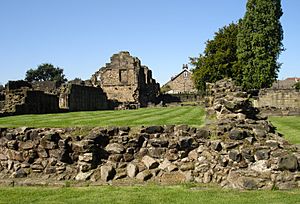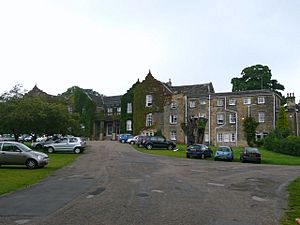William de Notton facts for kids
Sir William de Notton (who died around 1365) was an important English landowner and judge. He had a very successful career in both England and Ireland, eventually becoming the Lord Chief Justice of Ireland in 1361.
William belonged to a family of landowners called de Notton. They got their name from Notton in West Yorkshire. However, by the time William was born, the Notton lands belonged to another family, the Darcys. William bought several important properties himself. These included the manors of Fishlake, Monk Bretton, and Woolley Hall in Yorkshire. He also owned Litlington, Cambridgeshire, and Cocken Hatch near Royston, Hertfordshire. Cocken Hatch had previously belonged to John de Vere, 7th Earl of Oxford, who gave his lands there to William.
Contents
William's Early Career
William de Notton began his career serving on special legal groups called commissions. From 1343 to 1345, he worked on a commission that investigated serious crimes. In 1346, he became a Serjeant-at-law. This was a very high rank for a lawyer, showing he was excellent at arguing cases. His legal arguments were often written down in important law books of the time, called the Year Books.
In 1349, William became a Member of Parliament. This meant he helped make laws for the country. He also joined a group that looked into the working conditions of labourers (workers) and artisans (skilled craftspeople) in Surrey. A nearby landowner, John de Stainton, trusted William so much that he made him the guardian of his four daughters when he died. In 1353, William was part of a large commission. This group investigated all serious crimes that happened on the lands given by the King to Queen Philippa for her personal use.
Building a Chapel
In 1350, William and his wife Isabel made an important decision. They gave some of their lands at Fishlake, Monk Bretton, Woolley, and Moseley to John de Birthwaite. He was the Prior, or head, of Monk Bretton Priory. Their goal was to build a special chapel at Woolley. This chapel was called a chantry. In a chantry, prayers would be said for the King and his family. Prayers would also be said for William, Isabel, and their children.
This gift might have been inspired by the recent end of the first wave of the Black Death. This terrible illness, a type of plague, had swept across Europe. Many people felt thankful for surviving it and became more aware of how short life could be.
Later, in 1354-1355, William gave his lands at Cocken Hatch to the Prior of Royston. These were the lands he had received from the Earl of Oxford.

Becoming a Judge
In 1355, William de Notton was appointed a judge of the Court of King's Bench. This was one of the most important courts in England. When he was traveling as a judge in 1356, he was ordered to remove the Sheriffs of Oxfordshire and Northumberland from their jobs. Sheriffs were important local officials.
In 1357, he was part of a powerful group that investigated a fight. This fight was said to have happened between a servant of John Gynwell, who was the Bishop of Lincoln, and members of the Knights Hospitaller. Interestingly, the person accused of starting the fight, Richard de Wirkeley, was himself a former Lord Chief Justice of Ireland. Another former Irish Chief Justice, Henry de Motlowe, was also on this commission.
Later that same year, William served on another judicial commission. This group investigated the death of George de Longueville, a "chevalier" (knight), at Billing, Northamptonshire. His death was thought to be a murder. Longueville was also a Member of Parliament. He came from an important landowning family. Not much is known about how Longueville died or what the commission found.
Challenges and Later Life
In 1356, Thomas de Lisle, the Bishop of Ely, faced serious accusations. He was charged with encouraging the murder of William Holm, a servant of Blanche of Lancaster, who was the King's cousin. The Bishop and Blanche had a long-standing disagreement. He was also accused of hiding the murderers.
William de Notton was on the court that found the Bishop guilty. Because of this, William was called to appear before the Papal Court in Avignon in 1358. When he did not show up, he was excommunicated. This meant he was officially cut off from the Church. However, King Edward III clearly trusted William a lot. The King simply ignored the excommunication. William remained a judge on the King's Bench.
In 1361, William was sent to Ireland to become the Lord Chief Justice. In 1363, he was part of the Council that advised the King's second son, Lionel of Antwerp. Lionel was the Lord Lieutenant of Ireland, meaning he was the King's representative there.
William de Notton likely died in 1365. He was definitely gone before 1372, as his name no longer appeared in official records like the Patent Rolls and Close Rolls. He had at least two children with his wife, Isabel. However, much of his property went to Sir William Fyncheden, who was the Chief Justice of the Common Pleas in England. The exact connection between William de Notton and William Fyncheden is not clear.
Images for kids






